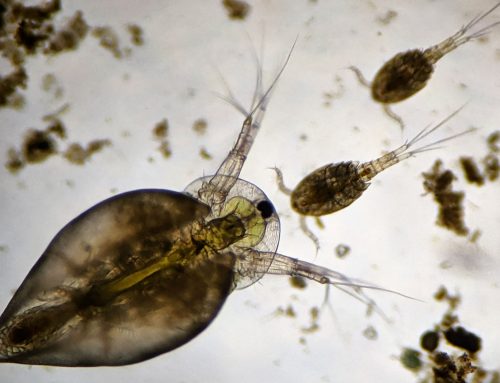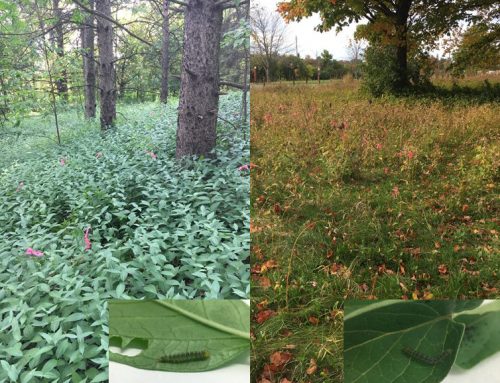In late October, although we’re still waiting for some seeds to mature before we can collect them, others are ready for their winter treatment.
So what is cold stratification? Essentially, it’s a temperature and moisture treatment used to break a seed’s dormancy and encourage germination. In nature, seeds fall to the ground, where they are covered by leaves and other pieces of decomposing vegetation. Snow falls, covering the seeds with a blanket and insulating them from extreme temperatures and drying wind. In spring, as the snow melts and the sun gradually warms the soil, the seeds germinate and begin to grow!
The need for this cold period to break dormancy is an adaptation to winter. Imagine if seeds germinated almost as soon as they fell off a plant; most plants would die as soon as the cold hit, as they would be too small to have sufficient root mass to survive.
Because we start plants for our annual June sale early, we need to be able to control when they go to sleep and wake up. This is surprisingly easy. All you need are small sealable baggies (we use the snack size), a bowl, a spoon, vermiculite, tepid water, and labels.
Note: The following instructions are for cold, moist stratification, needed by most seeds in our area. However, please check a suitable reference, such as the New England Wildflower Society’s Growing and Propagating Wildflowers, to find out which species need moisture, which should be stored dry, and which need no treatment at all.
1. Prepare damp vermiculite
Pour some vermiculite into the bowl and add just enough water to wet it. Wait a few minutes as the water is absorbed, then add more water until the vermiculite is damp to the touch. There should not be any standing water in the bottom of your bowl, but the flakes of vermiculite should look and feel moist. Stir with the spoon to distribute the moisture. Vermiculite is a mineral that holds a lot of water, making it ideal to keep the seed environment moist over a long period.
2. Prepare seeds
Remove seed cases and as much debris from the seeds as possible to reduce the likelihood of rot. Some casings contain germination inhibitors, so making sure the seeds are “clean” can be important.
We remove the silk parachutes from milkweed and open all seed pods to release the actual seeds. But we don’t try to pull the fluff off clematis, prairie smoke, goldenrod, or aster seeds.
3. Prepare baggies
Put about three spoonfuls of damp vermiculite into a baggie. Add just enough seeds that every one has lots of contact with the vermiculite. As a rough guide, the volume of vermiculite should be about twice that of the seeds.
We like to shake and then pat down the baggie to maximize contact. Gently push out most of the air, and seal the baggie. You now have a fairly flat, cool to the touch, and moist seed baggie ready for placing in the refrigerator. Don’t forget to label it! We use business labels, because they can be peeled off in spring and attached to our germination containers.
4. Store in a cold place
We have a mini-fridge dedicated to seeds, so moisture levels and temperature are constant (unless someone accidentally knocks the dial). However, your home refrigerator should be just fine, if you place your seeds near the back and away from where moisture tends to collect.
Now you can forget about your horde until late January or early February!
In early February, remove the baggies from the refrigerator and dump the entire contents into clear sandwich containers. Anything with a clear lid and no holes will work. Label each container so you know what is inside. Again, consult a good reference book to find out which species need light to germinate and which germinate in the dark.
Some seeds germinate almost immediately; others require considerable patience. Keep an eye on moisture levels – keep the vermiculite moist, but not wet. Once the sprouts have at least a couple of mini leaves (they look just like the edible sprouts you buy in stores at this stage) you can begin the next phase which is planting them into a seed starting soil mixture. But that is the subject for another post!









Hello, I’ve just read your post and I found it very interesting. I didn’t know about the stratification.
I’ve found a walnut that lately washed up on a beach, it had the skin and flesh.
I intend to have it germinating.
Do I have to let it dry before doing the stratification, or do I have to keep it damp?
Denis Calvès, Brest, France
Hi Denis, I have a good book, called “Growing Trees from Seed” by Henry Kock, a professor at Guelph University. He says NOT to let walnuts dry out, as they are less likely to germinate after they’ve been dried. Also, the hull (flesh) contains germination inhibitors, so best to remove it. They don’t seem to require refrigeration or any other pretreatment, but it might be a good idea to keep it in the refrigerator until you can plant it in the spring. Or you can plant it outside if you can protect it from being dug up and eaten by a squirrel. I hope this helps a bit and good luck growing your walnut tree.
Hi FWG
For what it’s worth, I was one of many students who was friends with Henry Koch when he worked at the Arboretum of the University of Guelph. Henry was a very dedicated arborist and technician, the kind of man who took it upon himself as a personal priority to locate, and note the location of, healthy elm trees that had successfully resisted the so-called Dutch Elm disease, the disease that wiped out so many elm trees in Eastern Canada. At the right season, Henry returned to collect seeds. Then Henry patiently germinated baby elms to replant in the Arboretum, and also to help repopulate the beautiful elms again across the landscape. It was tragic that Henry Koch died so young! The community held a huge memorial gathering to celebrate his life at the Arboretum Centre. That said, Henry was a wise and devoted specialist. He may have known more than many profs. But being Henry, he would be the first to say, I am not a prof!
Thanks for your great work for the FWG.